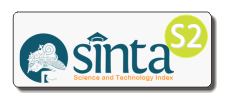Application rasch model using R program in analyze the characteristics of chemical items
Badrun Kartowagiran, Universitas Negeri Yogyakarta, Indonesia
Abstract
Keywords
Full Text:
FULLTEXT PDFReferences
Ackerman, T. A., Gierl, M. J., & Walker, C. M. (2003). Using multidimensional item response theory to evaluate educational and psychological tests. Educational Measurement: Issues and Practice, 22(3), 37–51. https://doi.org/10.1111/j.1745-3992.2003.tb00136.x
Allen, M. J., & Yen, W. M. (2001). Introduction to measurement theory. California: Waveland Press, Inc.
Anderson, L. W. (2003). Classroom assessment: Enhancing the quality of teacher decision making. New Jersey: Lawrence Erlbaum Associates, Inc.
Ary, D., Jacobs, L. C., Irvine, C. K. S., & Walker, D. (2018). Introduction to research in education. Cengage Learning.
Aziz, A., & Prasetyo, Z. (2015). Karakteristik soal ujian akhir semester gasal mata pelajaran fisika SMA kelas X di Kabupaten Lombok Tengah Nusa Tenggara Barat. Jurnal Evaluasi Pendidikan, 3(2), 99–111. Retrieved from http://journal.student.uny.ac.id/ojs/index.php/jep/article/view/1266
Bahar, A. (2013). The influence of cognitive abilities on mathematical problem solving performance. The University of Arizona.
Baumgartner, T. A., Jackson, A. (Tony), Mahar, M., & Rowe, D. (2007). Measurement for evaluation in physical education and exercise science. New York: McGraw-Hill.
Cohen, L., Manion, L., & Morrison, K. R. B. (2002). Research methods in education. New York, N.Y.: Routledge.
Crocker, L., & Algina, J. (2008). Introduction to classical and modern test theory. Ohio, USA: Cengage Learning.
Cronbach, L. J. (1984). Essentials of psychological testing. New York: Harper & Row Publisher.
Dada, E. M., & Ohia, I. (2014). Teacher-made language test planning, construction, administration and scoring in secondary schools in ekiti state. Journal of Education and Practice, 5(18), 71–76. Retrieved from https://www.iiste.org/Journals/index.php/JEP/article/view/13928
de Gruijter, D. N. M., & Van der Kamp, L. J. T. (2008). Statistical test theory for the behavioral sciences. Chapman and Hall.
Downing, S. M. (2003). Item response theory: applications of modern test theory in medical education. Medical Education, 37(8), 739–745. https://doi.org/10.1046/j.1365-2923.2003.01587.x
Embretson, S. E., & Reise, S. P. (2000). Item Response Theory for Psychologists Multivariate Applications Book Series. London: Lawrence Erlbaum Associates, Inc.
Finch, W. H., & French, B. F. (2015). Latent variable modeling with R. New York, N.Y.: Taylor & Francis.
Gregory, R. J. (2004). Psychological testing: History, principles, and applications. Allyn & Bacon.
Hambleton, R. K. (2018). Emergence of item response modeling in instrument development and data analysis. Medical Care, 38(9), II60–II65.
Hambleton, R. K., & Swaminathan, H. (1985). Item response theory: Principles and applications. New York, N.Y.: Springer Science+Business Media. https://doi.org/10.1007/978-94-017-1988-9
Harrison, P. M. C., Collins, T., & Müllensiefen, D. (2017). Applying modern psychometric techniques to melodic discrimination testing: Item response theory, computerised adaptive testing, and automatic item generation. Scientific Reports, 7(1), 1–19. https://doi.org/10.1038/s41598-017-03586-z
Iskandar, A., & Rizal, M. (2017). Analisis kualitas soal di perguruan tinggi berbasis aplikasi tap. Jurnal Penelitian Dan Evaluasi Pendidikan, 21(2), 12–23. https://doi.org/10.21831/pep.v22i1.15609
Kubiszyn, T., & Borich, G. D. (2013). Educational testing and measurement: Classroom application and practice (10th ed.). London: Wiley.
Linacre, J. M. (2015). Sample size and item calibration stability. Journal of Applied Measurement, 3(1).
Linden, W. J. van der, & Hambleton, R. K. (1996). Handbook of modern item response theory. New York, N.Y.: Springer Science+Business Media. https://doi.org/10.1007/978-1-4757-2691-6 I.
Lord, F. M., & Novick, M. R. (2008). Statistical theories of mental test scores. (F. Mosteller, Ed.). Addison-Wesley.
Mardapi, D. (2017). Pengukuran penilaian dan evaluasi pendidikan. Yogyakarta: Nuha Medika.
Maydeu-Olivares, A. (2013). Goodness-of-fit assessment of item response theory models. Measurement: Interdisciplinary Research and Perspectives, 11(3), 71–101. https://doi.org/10.1080/15366367.2013.831680
Miller, M. D., Linn, R. L., & Gronlund, N. E. (2009). Measurement and assessment in teaching. (L. Reinkober, Ed.) (10th ed.). Kevin M. Davis.
Ostini, R., & Nering, M. L. (2006). Polytomous item response theory models. Thousand Oaks, California: SAGE Publications, Inc.
Presiden Republik Indonesia. Peraturan pemerintah Republik Indonesia no 19 th 2005 tentang standar nasional pendidikan, Pub. L. No. 19, Peraturan pemerintah Republik Indonesia 1 (2005).
Reckase, M. D. (2009). Statistics for social and behavioral sciences: Multidimensional item response theory. New York, N.Y.: Springer Science+Business Media.
Retnawati, H. (2016). Validitas reliabilitas dan karakteristik butir. Yogyakarta: Parama Publishing.
Rizopoulos, D. (2006). ltm : An R package for latent variable modeling. Journal of Statistical Software, 17(5). https://doi.org/10.18637/jss.v017.i05
Salirawati, D. (2011). Pengembangan instrumen pendeteksi miskonsepsi kesetimbangan kimia pada peserta didik SMA. Jurnal Penelitian Dan Evaluasi Pendidikan, 15(2), 232–249. https://doi.org/10.21831/pep.v15i2.1095
Sutrisno, H. (2016). An analysis of the mathematics school examination test quality. Jurnal Riset Pendidikan Matematika, 3(2), 162–177. https://doi.org/10.21831/jrpm.v3i2.11984
Taub, G. E., Floyd, R. G., Keith, T. Z., & McGrew, K. S. (2008). Effects of general and broad cognitive abilities on mathematics achievement. School Psychology Quarterly, 23(2), 187–198. https://doi.org/10.1037/1045-3830.23.2.187
Tshabalala, T., Mapolisa, T., Gazimbe, P., & Ncube, A. C. (2015). Establishing the effectiveness of teacher-made tests in Nkayi District Primary Schools. Nova Journal of Humanities and Social Sciences, 4(1), 1–6. https://doi.org/10.20286/jhss.v4i1.29
Van Alphen, A., Halfens, R., Hasman, A., & Imbos, T. (1994). Likert or rasch ? Nothing is more applicable than good theory. Journal Af Advanced Nursing, 20, 196–201. https://doi.org/10.1046/j.1365-2648.1994.20010196.x%0A
Van de Walle, J. A. (2010). Elementary and middle school mathematics : teaching developmentally. Boston: Pearson /Allyn and Bacon.
DOI: https://doi.org/10.21831/jipi.v5i2.24235
Refbacks
- There are currently no refbacks.
Copyright (c) 2019 Jurnal Inovasi Pendidikan IPA

This work is licensed under a Creative Commons Attribution-ShareAlike 4.0 International License.
Jurnal Inovasi Pendidikan IPA indexed by:

Jurnal Inovasi Pendidikan IPA by http://journal.uny.ac.id/index.php/jipi/index is licensed under a Creative Commons Attribution-ShareAlike 4.0 International License.
All rights reserved. p-ISSN: 2406-9205 | e-ISSN: 2477-4820
View My Stats














